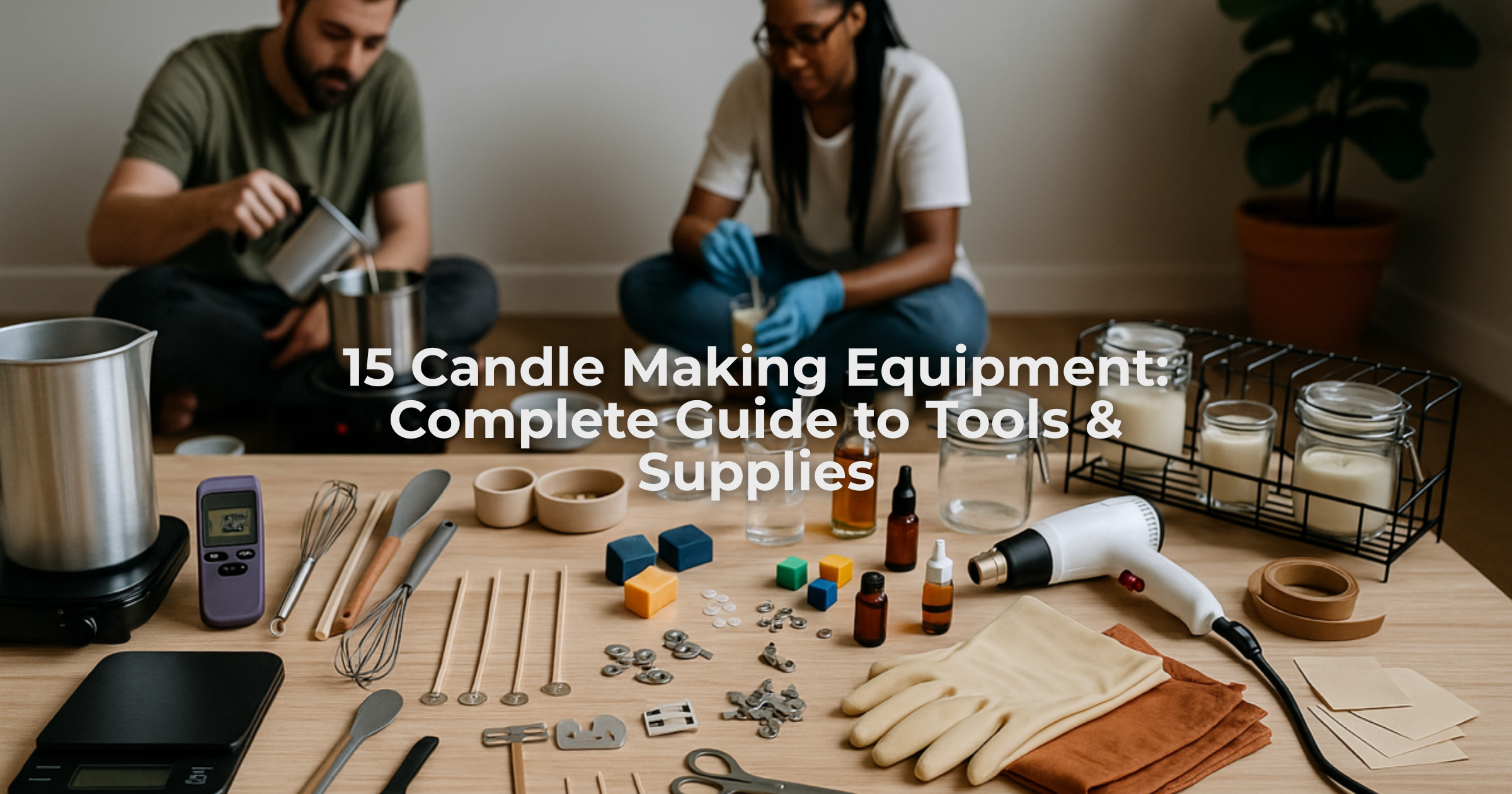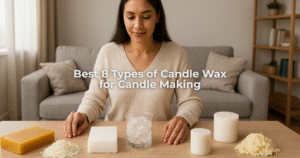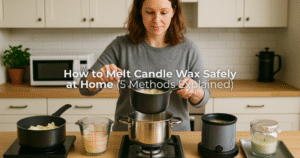15 Candle Making Equipment: Complete Guide to Tools & Supplies

When it comes to crafting candles, the difference between a lopsided, uneven wax block and a smooth, professional-quality candle often comes down to one thing: having the right candle-making equipment.
Even the most creative ideas fall flat if you don’t have the proper setup. The right candle tools not only save time but also ensure that your candles burn evenly, look polished, and carry fragrance the way they should.
This guide covers the 15 most important candle-making tools, from beginner-friendly essentials to advanced professional candle-making equipment.
Whether you’re experimenting with a DIY kit, setting up a small business, or considering commercial candle-making equipment, these are the supplies you’ll want in your workshop.
Along the way, we’ll explore different variations like tools for candle making, equipment to make candles, and supplies needed for candle making, so you’ll know exactly what fits your level and style.
15 Candle Making Tools You Need
1. Pouring Pitcher (Melting Pot)
A pouring pitcher is the backbone of any candle station. It’s where you melt your wax, mix in colors and fragrances, and pour your blend into molds or jars.
Aluminum or stainless steel pitchers are most common because they handle heat well and are easy to clean. For beginners, a single pouring pot is enough.
But if you’re working with multiple fragrances or colors, having several pitchers helps keep batches separate. In equipment for candle making, this is often the first purchase after wax and wicks.

2. Digital Thermometer
Temperature is everything in candle making. Too hot, and your fragrance evaporates; too cool, and the wax sets unevenly.
A digital thermometer takes the guesswork out of the process, ensuring your wax reaches the perfect melting and pouring range.
Infrared thermometers are handy for quick checks, while probe-style thermometers give more accurate readings inside the wax. Every set of candle-making tools should include one.

3. Candle Wicks and Wick Holders
Wicks are the literal lifeline of a candle. They control how evenly your candle burns and how much scent is released. Cotton, wood, and eco-friendly hemp wicks are all common choices.
Wick holders, like clips or sticks, keep the wick centered while the wax sets, preventing lopsided burns. When building your kit of candle tools, always stock up on a variety of wick sizes to match your containers and wax types.

4. Heat Source (Double Boiler / Hot Plate)
You’ll need a safe and steady way to melt your wax. A double-boiler setup is great for beginners; it’s essentially one pot stacked inside another with water underneath, preventing the wax from burning.
For larger batches, hot plates or induction burners give more control. Scaling up often means upgrading to commercial candle-making equipment, but for most DIY makers, a double boiler remains a trusty classic.

5. Candle Molds and Containers
Candles come in all shapes and styles, and so do the molds. Silicone molds allow flexibility for creative shapes, while metal molds provide a professional finish.
Glass jars and tins are container favorites, especially for home decor and gifting.
Choosing the right molds or containers is one of the most fun parts of building your collection of supplies needed for candle making.

6. Digital Scale
Measuring wax and fragrance by eye is a recipe for inconsistency. A digital scale ensures accuracy when weighing out ingredients.
Too little fragrance oil and your candle won’t carry a strong scent; too much and the wick may clog.
A scale helps maintain balance in every batch, which is especially important when you transition to professional candle-making equipment where precision drives quality.

7. Stirring Utensils (Spatulas, Whisks, Stirrers)
Once the wax is melted, stirring evenly distributes colorants and fragrance oils. Heat-resistant silicone spatulas are great because they don’t warp, while whisks help break up clumps of dye or powdered additives.
Keeping dedicated stirring utensils in your collection of tools for making candles ensures each batch is mixed properly and consistently.

8. Wax Melter (Commercial-Grade Option)
When making larger batches, a wax melter is a game-changer. Unlike small pouring pitchers, wax melters can hold several pounds of wax at once, with built-in thermostats to keep temperatures steady.
This type of commercial candle-making equipment saves hours of melting time and helps businesses produce candles on a larger scale without compromising quality.

9. Fragrance Measuring Tools (Droppers, Pipettes, Beakers)
Adding fragrance oil is one of the most delicate steps. Too much or too little alters the scent throw drastically.
Droppers and pipettes help with small batches, while glass beakers are ideal for larger pours.
Keeping these candle-making tools on hand ensures your scents remain consistent, especially if you plan to sell candles professionally.

10. Coloring Tools (Dye Blocks, Liquid Dyes, Chips)
Color adds personality to candles, and having the right coloring tools makes a difference.
Dye blocks create rich tones, liquid dyes allow precise blending, and chips are easy for beginners to measure.
Experimenting with coloring tools is one of the joys of collecting equipment to make candles, and each type of dye creates unique effects.

11. Wick Centering Devices and Clips
Even with wick holders, wax can shift the wick slightly off-center. Centering devices, such as metal clips or reusable plastic holders, keep wicks firmly in place as the wax sets.
This is one of those small but essential tools for candle making that prevent wasted batches and uneven burns.

12. Heat Gun (Surface Finishing Tool)
A heat gun is perfect for smoothing out imperfections like sinkholes or bubbles that form as candles cool. By gently reheating the surface, you get a polished, professional finish.
Many makers consider a heat gun optional at first, but it quickly becomes a must-have in a serious collection of candle-making tools.

13. Protective Gear (Gloves, Apron, Heat-Resistant Surface)
Candle making involves hot wax, dyes, and fragrance oils, which can cause burns or spills.
Protective gloves and aprons safeguard you from accidents, while heat-resistant mats protect your work surface.
Safety is a key part of every list of supplies needed for candle making, and protective gear should never be skipped.

14. Storage Jars and Curing Racks
Freshly made candles often need to cure before reaching their best burn and fragrance performance. Storage jars, shelves, or curing racks allow candles to rest in a controlled space.
For anyone scaling up production, curing racks become part of your professional candle-making equipment, ensuring batches are organized and ready to package.

15. Labeling and Packaging Tools
Labels, stickers, and packaging supplies transform homemade candles into professional products.
Clear labeling also ensures safety, especially if you’re selling candles with specific fragrance oils or blends.
Packaging tools may feel secondary at first, but they’re an essential part of equipment for candle making if you’re moving into business territory.

How to Choose the Right Candle Making Equipment
Choosing the right candle-making equipment depends on where you are in your journey. Beginners may only need a melting pot, thermometer, wicks, and containers.
As you progress, adding tools like a digital scale, wick holders, and a heat gun improves your results. For hobbyists becoming entrepreneurs, investing in professional candle-making equipment such as wax melters, curing racks, and labeling tools allows for larger batch sizes and consistent quality.
Scaling up also depends on your candle style. If you work with soy wax, you’ll want pitchers and thermometers tuned for lower melting points.
Paraffin requires more precise temperature control. If you’re producing container candles, jars, and wick holders are key.
For pillar candles, molds and centering devices become more important. Budget is another factor; start small with basic tools for making candles and upgrade only when needed.
At the end of the day, your setup should reflect your goals. DIY makers can thrive with a modest candle-making kit, while scaling into sales usually means investing in commercial candle-making equipment to streamline the process.
Final Thoughts
The art of candle making becomes much easier and much more rewarding when you have the right equipment to make candles.
From the simple stirring spatula to large-scale wax melters, every tool plays a role in the final look, scent, and performance of your candles.
By starting with the essentials and expanding your kit over time, you can enjoy the process while achieving consistently professional results.
If you’re just beginning, stick with the best supplies needed for candle making ,like pitchers, wicks, and a thermometer.
As you grow, bring in more advanced candle tools like heat guns, curing racks, and labeling gear. For those who dream of running a business, upgrading to professional candle-making equipment ensures efficiency and polish.
With the right tools in hand, candle making is no longer a guessing game; it’s a craft you can master. Invest in the best tools for making candles, and every flame you light will feel like the work of a true artisan.
-
Nav Preet is the founder and creative soul behind Karigar Candles. Inspired by heritage, nature, and the warmth of handmade artistry, she crafts candles that do more than glow—they evoke emotion. Through this blog, she shares her love for scents, styling, and mindful living, one flame at a time.
Creative Head at Karigar Style







